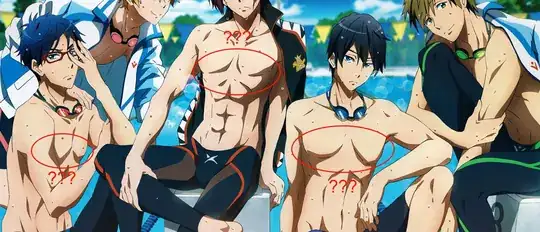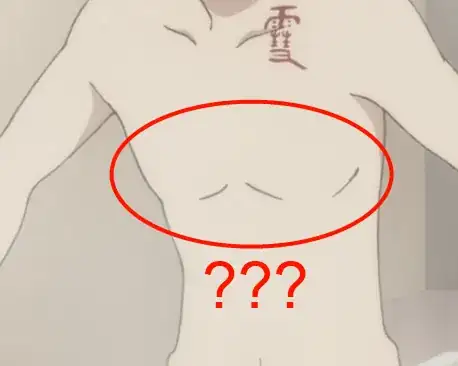Animated male nipples are not a matter of legal Japanese censorship (or copyright law). It is fine to air them on TV in prime time. As Ray noted in a deleted answer, Dragonball, viewed as a most-typical shounen anime aimed at children, features male characters whose nipples are easily visible. Although the series garnered many adult and female fans, the characters are not particularly intended to look comely or provocative to the target audience. The innocuous nipples in Dragonball can be there because they are not intended to be viewed as attractive.
In contrast, mainstream character designs that aim to captivate the viewer in a romantic or sensual way are more likely to be nipple-free, because a well-known aspect of creating fantasy is to paint a rosy picture and subtly remove pesky details that can snap a viewer out of the lovely reverie back to stark reality (the old adage “less is more”). Nipples are not considered to contribute toward this end, in the same way that Japanese people do not generally shave or wax (since this site is 13+ I'm not going to provide citation links but you could Google that) but we are never shown body hair in regular manga and anime: in real-life, we know these anatomically exist, but drawing them does not help the audience escape into daydream. (Hentai titles and hentai doujinshi have a different goal, so that is why you are more likely to see male nipples there than in mainstream titles.)
Free! is a bishounen (pretty boy) title, so the characters are intentionally drawn to be eye candy. Even more so than the earlier bishounen anime series, Free! and other more recent titles such as Binan Koukou Chikyuu Bouei Bu Love!, Uta no Prince-sama, Harukanaru Toki no Naka de, Kiniro no Corda, Dance with Devils, Diabolik Lovers, Brothers Conflict, K, Kamigami no Asobi, Starry Sky, Shounen Hollywood: Holly Stage for 49, etc. focus heavily on the eye candy aspect, such as including stages of undress, characters striking sensual poses, “camera” angles and lingering shots that accentuate their figures, etc. The character design is intended to garner fans who crush on the characters and buy all manner of merchandise sporting those characters.
Bishounen characters are not as prevalent in shounen titles as in shoujo, but they are now widespread (f you look at the bulk of shounen series from the 80s, 70s, and 60s, you will find far fewer bishounen characters there, especially as primary protagonists), partly based on changing cultural preferences (something along the lines of metrosexual) and partly on expanding otaku demographics (pulling in the potential female audience can be more financially-viable than it was in the past). Noragami is not marketed toward women, but it follows in the current trend within shounen series of those that try to appeal to readers/viewers beyond the target demographic.
Historically, the naked body was not considered to be attractive in Japanese culture. The classic Heian era (11th century) novel The Tale of Genji illustrates how people wore layers and layers of clothes (women wore 12 layers), and had sex while (nearly) fully dressed and in the dark (see pages 30-32 of The Tale of Genji by Murasaki Shikibu: A Reader's Guide by William J. Puette). Some consider the origin of bishounen to date as far back in Japanese literature as the protagonist of The Tale of Genji (i.e. Hikaru Genji as the proto-bishounen). Genji was the era's ideal man. He considered imagining his lover without looking closely as preferable to viewing the unattractive details of her actual body.

